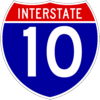San Bernardino Freeway
From Wikipedia, the free encyclopedia.
| San Bernardino Freeway | ||||
| Signed as | ||||
 Interstate 10 |
||||
|
||||
| Southern California freeways |
The San Bernardino Freeway is the assigned name of an approximately 60-mile (95 km) long segment of Interstate 10 (I-10) between the cities of Los Angeles, California and San Bernardino, California. It is one of the principal development axes of Greater Los Angeles, with numerous suburban communities along its route.
Contents |
The Route
Starting at the East Los Angeles Interchange complex, it travels east through the San Gabriel Valley and the Pomona Valley. It then crosses the Los Angeles/San Bernardino county line and enters the Inland Empire. At the Interstate 215 interchange located in San Bernardino this segment of Interstate 10 ceases to be the "San Bernardino Freeway". Beyond this interchange, I-10 continues eastward through the communities of Redlands and Loma Linda and leads southeast into Riverside County. Following its traverse of the San Gorgonio Pass it continues eastward to the California/Arizona stateline. Beyond that point refer to the Interstate 10 page.
Major alternate east-west routes are the Foothill Freeway (I-210), the Pomona Freeway (CA/SR-60), and the Riverside Freeway (CA/SR-91).
History and features
The precursor to the San Bernardino Freeway was built in 1944 to connect the then-new Kaiser Steel mill in Fontana to war industries in downtown Los Angeles. The relatively primitive nature of the road can be seen in the architecture of the onramps and offramps to roads in the western San Gabriel Valley, which require sharp, dangerous turns at low speed in order to enter or exit the freeway.
The massive volume of commuters traveling between Los Angeles and its eastern suburbs, and the heavy commercial truck traffic transporting goods/materials between the ports of Los Angeles and Long Beach and the railroad yards and warehouses in the Inland Empire, make the San Bernardino Freeway one of the busiest freeway corridors in the United States. In response to severe congestion in the early 1970s, the California Department of Transportation, otherwise known as Caltrans, renovated the freeway segment between the downtown Los Angeles and El Monte to incorporate one of the earliest examples of high-occupancy vehicle (HOV) or "carpool" lanes.
The El Monte Busway, as it is known, opened in 1974 to buses only, and in 1976 opened to carpools as well. The eastern terminus of the carpool lanes was near the El Monte bus depot in El Monte at the intersection with Baldwin Avenue, until it was extended 2 miles in 2005 to the San Gabriel River Freeway. The western terminus of the carpool lanes is at the East Los Angeles Interchange complex, although the busway itself continues to the Patsaouras Transit Plaza at Union Station in downtown Los Angeles. The resulting carpool roadway is one of the few indisputably successful mass transit projects undertaken in Southern California.
Uniquely, the carpool lanes of the El Monte Busway can only be entered and exited at a few points as the entire length is demarcated with two 'double-yellow' lines (which are technically illegal to cross) and an approximately 12' (3.7m) wide asphalt median; carpool lanes in other California freeways (including other segments of the San Bernardino Freeway) generally allow entry and exit at multiple points which generally coincide with a nearby street or freeway interchange. The entrances and exits are at the San Gabriel River Freeway, Baldwin Avenue in El Monte, Eastern Avenue in East Los Angeles, and at Union Station. Additionally, westbound there are exits at the Long Beach Freeway and at the Hollywood Freeway.
The San Bernardino Line of the Metrolink runs in the freeway's center median between El Monte and I-710, then travels along the north side of the freeway to the East Los Angeles Interchange.
Beginning in the 1990s, additional HOV lanes have been added (one lane per direction) to the freeway segment between the Kellogg interchange complex in Pomona and the interchange with the Ontario Freeway, Interstate 15 (I-15) in Ontario.
Legal definition
Route 10 from Route 101 to Route 215. [State Highway Commission (11/18/1954)]
Source: 2004 Named Freeways, Highways, Structures and Other Appurtenances in California (PDF)
Cities/Communities along the San Bernardino Freeway (west to east)
- Boyle Heights
- Monterey Park
- Alhambra
- San Gabriel
- Rosemead
- El Monte
- Baldwin Park
- West Covina
- Covina
- San Dimas
- Pomona
- Claremont
- Montclair
- Upland
- Ontario
- Fontana
- Bloomington
- Rialto
- Colton
- San Bernardino
Major Freeways/Highways intersecting the San Bernardino Freeway (west to east)
 Santa Ana Freeway;
Santa Ana Freeway; Santa Ana Freeway/Golden State Freeway; and
Santa Ana Freeway/Golden State Freeway; and Santa Monica Freeway - at the East Los Angeles Interchange at about 34° 02' 37"N, 118° 13' 09"W
Santa Monica Freeway - at the East Los Angeles Interchange at about 34° 02' 37"N, 118° 13' 09"W Long Beach Freeway - in Commerce at 34° 03' 40"N, 118° 09' 55"W
Long Beach Freeway - in Commerce at 34° 03' 40"N, 118° 09' 55"W San Gabriel River Freeway - in Baldwin Park at 34° 03' 54"N, 118° 00' 00"W
San Gabriel River Freeway - in Baldwin Park at 34° 03' 54"N, 118° 00' 00"W Foothill Freeway - before late 2003, Orange Freeway
Foothill Freeway - before late 2003, Orange Freeway  after late 2003 (at the Kellogg interchange complex) in San Dimas at 34° 03' 55"N, 117° 48' 23"W
after late 2003 (at the Kellogg interchange complex) in San Dimas at 34° 03' 55"N, 117° 48' 23"W - Chino Valley Freeway - (at the Kellogg interchange complex) in San Dimas
- Chino Valley Freeway - (at the Kellogg interchange complex) in San Dimas - Ontario Freeway in Ontario at 34° 04' 03"N, 117° 32' 42"W
- Ontario Freeway in Ontario at 34° 04' 03"N, 117° 32' 42"W - Escondido Freeway in San Bernardino at 34° 03' 51"N, 117° 17' 47"W
- Escondido Freeway in San Bernardino at 34° 03' 51"N, 117° 17' 47"W




